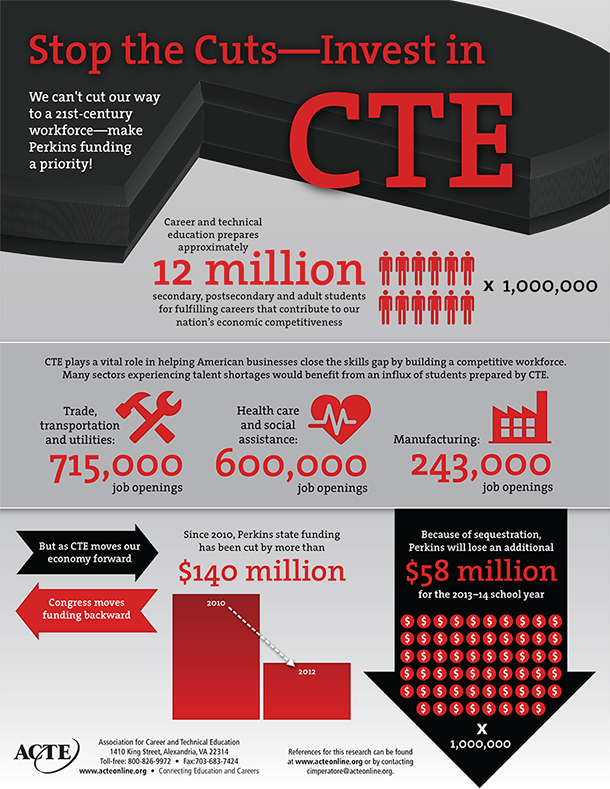 With nearly every state in the country working to implement the Common Core State Standards in mathematics and English/Literacy, and more and more resources and information being generated by states, districts, schools and education-focused organizations to support implementation, NASDCTEc is excited to present a blog series on the Common Core State Standards and Career Technical Education! The blog features news and resources that directly impact CTE educators as well as other materials we think are useful to the field. This edition features many communications-focused materials and resources.
With nearly every state in the country working to implement the Common Core State Standards in mathematics and English/Literacy, and more and more resources and information being generated by states, districts, schools and education-focused organizations to support implementation, NASDCTEc is excited to present a blog series on the Common Core State Standards and Career Technical Education! The blog features news and resources that directly impact CTE educators as well as other materials we think are useful to the field. This edition features many communications-focused materials and resources.
In the News…
As you may have seen, New York State just released the results from its first year of administering CCSS-aligned assessments administered and, as expected, scores dropped fairly dramatically statewide. (Read more about it here). Kentucky experienced a similar drop in scores last year when they first moved to a CCSS-aligned assessment.
Featured Resources & Tools
The Center for Education Policy released “Year 3 of Implementing the Common Core State Standards: State Education Agencies’ Views on the Federal Role,†the third annual survey and report on states’ progress in implementing the Common Core State Standards. Major findings include:
- Thirty-seven of the 39 CCSS-adopting states that responded to the survey consider it “unlikely†that their state would reverse, limit, or change its decision to adopt the standards during 2013-14. In fact, very few respondents said that overcoming resistance to the Common Core posed a major challenge in their state – with no states saying resistance from within the K-12 system posed a major challenge. This is heartening as the survey was conducted in Spring 2013, when opposition was spreading in many state legislatures, but blocked in nearly every state.
- At least 30 of the CCSS-adopting states indicated support for particular legislative changes to the Elementary and Secondary Education Act (ESEA) that would directly assist state and district efforts to transition to the Common Core, including supporting professional development or funding for the common assessments.
- And, 22 of the 29 responding CCSS-adopting states that received ESEA waivers found them to be helpful in supporting the transition of the CCSS.
A number of pro-CCSS websites were launched this summer, most notably Conservatives for Higher Standards, which highlights a range of right-leaning political leaders’ positive positions on the CCSS and debunks many of the false claims about the CCSS currently being spread in some political factions, and iAdvocate for Students, a website managed by three PTA volunteers, who are classroom teachers and/or mothers of K-12 students that features positive stories on the CCSS.
To both promote a number of their own tools for supporting the implementation of the CCSS and to better coordinate related resources, Achieve, the Council of Chief State School Officers and Student Achievement Partners released a joint Toolkit for Evaluating the Alignment of Instructional and Assessment Materials to the CCSS.  This Toolkit features the Instructional Materials Evaluation Tools; the EQuIP rubrics for evaluating lessons and units; the Assessment Evaluation Tool; the Assessment Passage and Item Quality Criteria Checklist; Publisher’s Criteria for the CCSS; and a list of additional resources relevant to evaluating instructional materials’ alignment to the CCSS.
The Data Quality Campaign (of which NASDCTEc is a partner organization) has released a number of short resources to help leaders explain how education data can be utilized and to help dispel myths that CCSS will somehow require the sharing of any student-level data. Notable resources include What Every Parent Should Be Asking about Education Data (co-developed with the PTA) and Talking about the Facts of Education Data with Policymakers and Parents.
Finally, the GE Foundation hosted its third annual Business and Education Summit last month, bringing together business and education leaders from across the nation to discuss the Common Core State Standards, Next Generation Science Standards, college- and career-ready assessment and accountability systems, and how the business community can best support state and local efforts to implement such policies and practices. In advance of the Summit, GE Foundation conducted a survey of the business participants. Among the 52 executives who responded:
- 87% say the new CCSS are “mission critical†to American business;
- 64% say they have undertaken some efforts to support standards implementation; and
- 57% say that their organization has had some jobs not filled as a result of skills gap.
Updates on Common Core Assessments
Consortia Musical Chairs: Georgia has withdrawn as a PARCC governing state, while North Dakota and Wyoming officially became governing states within Smarter Balanced.
Also major news is that cost estimates are now available from both consortia. PARCC’s summative assessments are priced just below the $29.95 per pupil median level of spending on summative tests in those two subjects in the consortium’s states. Smarter Balanced is offering two pricing options for states, $22.50 per student (which includes only summative tests) and $27.30 per student (which includes summative as well as interim and formative tests). The higher price tags are associated with more meaningful test items (aka no more “fill-in-the-bubble†tests).
The Partnership for Assessment of Readiness for College and Careers (PARCC)
PARCC released information on the field testing that will occur in 14 states and Washington DC in the Spring of 2014, for about 10% of all potential test takers. The field test will allow the states to test the accommodations policies and tools, assessment items and the technology. Â Over this past summer, small-scale item tryouts occurred across ten states to begin to garner critical data. Tested items are expected to be released to the public in coming weeks.
PARCC recently released the first edition of the Accessibility Features and Accommodations Manual, along with a set of supporting communications materials.
Finally, PARCC has formally amended its grant for Race to the Top funding to fully operate as an independent 501(c)(3) nonprofit organization with its own funding, board of directors, staff and programs. This change aims to provide PARCC with a long-term sustainable architecture to support states in the operations of the assessment system beyond 2014 when the Race to the Top grant comes to a close. For more, see here.
Have a good CCSS-CTE resource to share? Contact us at [email protected]!
Kate Blosveren, Associate Executive Director
 After years of anticipation, Congress has taken steps toward reauthorizing several pieces of legislation that impact CTE including the Carl D. Perkins Career and Technical Education Act, the Workforce Investment Act, the Elementary and Secondary Education Act, and the Higher Education Act. In addition to updates on these key pieces of legislation, we will discuss sequestration and debates over the FY14 budget.
After years of anticipation, Congress has taken steps toward reauthorizing several pieces of legislation that impact CTE including the Carl D. Perkins Career and Technical Education Act, the Workforce Investment Act, the Elementary and Secondary Education Act, and the Higher Education Act. In addition to updates on these key pieces of legislation, we will discuss sequestration and debates over the FY14 budget.

 In recent years, the costs of higher education in the United States have risen more quickly than any other sector of our economy. According to the Department of Labor, college tuition and fees have increased
In recent years, the costs of higher education in the United States have risen more quickly than any other sector of our economy. According to the Department of Labor, college tuition and fees have increased 
 NASDCTEc would like to welcome Steve Voytek, who recently joined our team as a Government Relations Associate. Steve will be promoting the organization’s policy priorities and legislative objectives for Career Technical Education by engaging policymakers and stakeholders at an important time for CTE legislation.
NASDCTEc would like to welcome Steve Voytek, who recently joined our team as a Government Relations Associate. Steve will be promoting the organization’s policy priorities and legislative objectives for Career Technical Education by engaging policymakers and stakeholders at an important time for CTE legislation.

